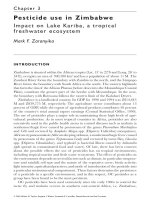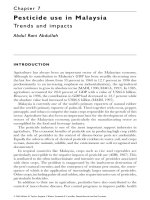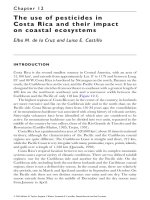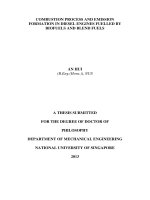Excellence in business communication 12e by vthill and brovee chapter 05
Bạn đang xem bản rút gọn của tài liệu. Xem và tải ngay bản đầy đủ của tài liệu tại đây (678.68 KB, 39 trang )
Copyright © 2017 Pearson Education, Inc.
Excellence in
in
Excellence
Business Communication
Communication
Business
Chapter 5
Writing Business Messages
Copyright © 2017 Pearson Education, Inc.
Learning Objectives
1.
(1 of 3)
Identify the four aspects of being sensitive to audience needs
when writing business messages.
2.
Explain how establishing your credibility and projecting your
company’s image are vital aspects of building strong
relationships with your audience.
Copyright © 2017 Pearson Education, Inc.
Chapter 5 - 3
Learning Objectives
3.
(2 of 3)
Explain how to achieve a tone that is conversational but
businesslike, explain the value of using plain language, and
define active and passive voice.
4.
Describe how to select words that are both correct and
effective.
Copyright © 2017 Pearson Education, Inc.
Chapter 5 - 4
Learning Objectives
5.
(3 of 3)
Define the four types of sentences, and explain how sentence
style affects emphasis within a message.
6.
Define the three key elements of a paragraph, and list five
ways to develop unified, coherent paragraphs.
7.
List five techniques for writing effective messages for mobile
readers.
Copyright © 2017 Pearson Education, Inc.
Chapter 5 - 5
Adapting to
to Your
Your Audience:
Audience: Being
Being Sensitive
Sensitive
Adapting
to Your
Your Audience’s
Audience’s Needs
Needs
to
(LO 1) Identify the four aspects of being sensitive to audience
needs when writing business messages.
Copyright © 2017 Pearson Education, Inc.
Chapter 5 - 6
Adopting a “You” Attitude
(1 of 2)
Audience-Centered Approach
Approach
Audience-Centered
Hopes
Hopes
Copyright © 2017 Pearson Education, Inc.
Wishes
Wishes
Interests
Interests
Preferences
Preferences
Chapter 5 - 7
Adopting a “You” Attitude
(2 of 2)
Copyright © 2017 Pearson Education, Inc.
Chapter 5 - 8
Maintaining Standards
of Etiquette
Respect
(1 of 2)
Diplomacy
Tactfulness
Copyright © 2017 Pearson Education, Inc.
Chapter 5 - 9
Maintaining Standards
of Etiquette
Copyright © 2017 Pearson Education, Inc.
(2 of 2)
Chapter 5 - 10
Emphasizing the Positive
(1 of 2)
•
Avoid Negative Language:
– Focus on ways to improve.
– Emphasize audience benefits.
•
Use Euphemisms Appropriately:
– Be honest but not harsh.
– Don’t hide the facts.
Copyright © 2017 Pearson Education, Inc.
Chapter 5 - 11
Emphasizing the Positive
(2 of 2)
Copyright © 2017 Pearson Education, Inc.
Chapter 5 - 12
Using Bias-Free Language
(1 of 2)
Gender
Age
Avoid Bias
Race/Ethnicity
Copyright © 2017 Pearson Education, Inc.
Disability
Chapter 5 - 13
Using Bias-Free Language
(2 of 2)
Copyright © 2017 Pearson Education, Inc.
Chapter 5 - 14
Adapting to
to Your
Your Audience:
Audience: Building
Building Strong
Strong
Adapting
Relationships
Relationships
(LO 2) Explain how establishing your credibility and projecting your
company’s image are vital aspects of building strong relationships
with your audience.
Copyright © 2017 Pearson Education, Inc.
Chapter 5 - 15
Establishing Your Credibility
(1
(1 of
of 2)
2)
Honesty
Objectivity
Awareness of Audience
Credentials, Knowledge,
Needs
and Expertise
Copyright © 2017 Pearson Education, Inc.
Chapter 5 - 16
Establishing Your Credibility
(2
(2 of
of 2)
2)
Endorsements
Performance
Sincerity
Self-Confidence
Copyright © 2017 Pearson Education, Inc.
Chapter 5 - 17
Projecting Your
Company’s Image
Communication Style
Style
Communication
Copyright © 2017 Pearson Education, Inc.
Communication
Communication
Guidelines
Guidelines
Chapter 5 - 18
Adapting to
to Your
Your Audience:
Audience: Controlling
Controlling Your
Your
Adapting
Style and
and Tone
Tone
Style
(LO 3) Explain how to achieve a tone that is conversational but
businesslike, explain the value of using plain language, and define
the active and passive voice.
Copyright © 2017 Pearson Education, Inc.
Chapter 5 - 19
Creating a
Conversational Tone
Don’tConfuse
ConfuseTexting
Textingand
andWriting
Writing
Don’t
AvoidStale
Staleand
andObsolete
ObsoleteLanguage
Language
Avoid
AvoidPreaching
Preachingand
andBragging
Bragging
Avoid
BeCareful
Carefulwith
withIntimacy
Intimacyand
andHumor
Humor
Be
Copyright © 2017 Pearson Education, Inc.
Chapter 5 - 20
Using Plain Language
Prefer a Simple, Unadorned Style
Support the “You” Attitude
Show Respect for the Audience
Boost Productivity and Profitability
Copyright © 2017 Pearson Education, Inc.
Chapter 5 - 21
Selecting Active Voice
or Passive Voice
(1 of 2)
Dull and
and Indirect
Indirect (Passive
(Passive Voice)
Voice)
Dull
•
•
Legal problems are created by this contract.
The new system was proposed by the project team.
Lively and
and Direct
Direct (Active
(Active Voice)
Voice)
Lively
•
•
This contract creates legal problems.
The project team proposed a new system.
Copyright © 2017 Pearson Education, Inc.
Chapter 5 - 22
Selecting Active Voice
or Passive Voice
(2 of 2)
Accusatory or
or Self-Congratulatory
Self-Congratulatory (Active
(Active Voice)
Voice)
Accusatory
•
•
You lost the shipment.
I recruited seven engineers last month.
More Diplomatic
Diplomatic (Passive
(Passive Voice)
Voice)
More
•
•
The shipment was lost.
Seven engineers were recruited last month.
Copyright © 2017 Pearson Education, Inc.
Chapter 5 - 23
Composing Your
Your Message:
Message: Choosing
Choosing Powerful
Powerful
Composing
Words
Words
(LO 4) Describe how to select words that are both correct and
effective.
Copyright © 2017 Pearson Education, Inc.
Chapter 5 - 24
Choosing Powerful Words
Grammar
Grammar
Effective
Effective
Usage
Usage
Strong Words
Words
Strong
Experience
Experience
Correct
Correct
Copyright © 2017 Pearson Education, Inc.
Judgment
Judgment
Chapter 5 - 25









